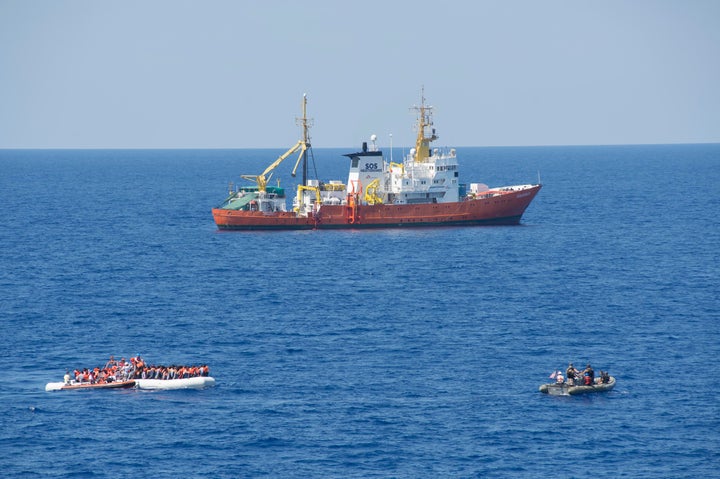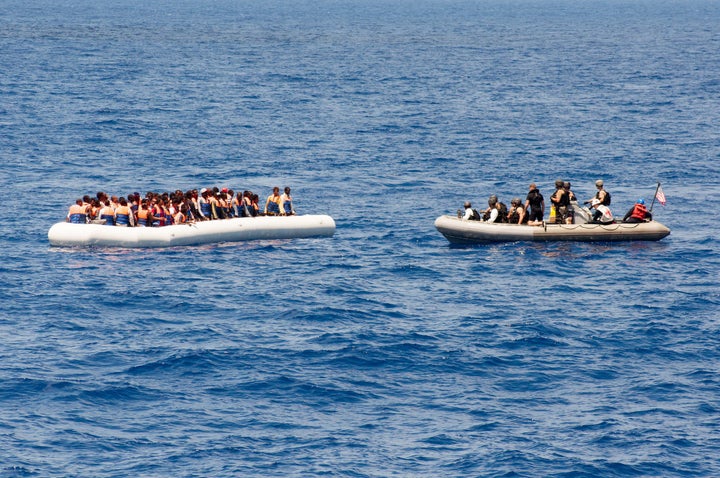
Members of the SOS Mediterranean ship MS Aquarius rescue migrants on a small craft in the Mediterranean Sea. July 29, 2016.
This Sunday, April 9, will mark one year since a migrant boat heading for Italy capsized off the Mediterranean coast of Egypt, killing over five hundred men, women and children, the great majority of which were migrants from East African countries. Since then, several more smuggling boats attempting to reach Europe have crashed in the Mediterranean, resulting in thousands of additional deaths and disappearances. There has been no investigation into the causes and perpetrators of the fatal boat crash by any official international body since, including the UN, the EU, NATO, as well as any maritime or police agencies.
The fact that these migrants continue to risk their lives on this perilous journey only serves to demonstrate the extent of the dire conditions that they face in Egypt. Sudanese migrants represent, by far, the largest share of Egypt’s migrant population, with three to five million Sudanese immigrants living in the country, 28,000 of which are registered as refugees with UNHCR. According to the organization, more than 650 Sudanese refugees and asylum seekers were detained for trying to leave Egypt irregularly in 2015, constituting the great majority of those trying to leave the country.
Rapidly decreasing conditions for migrants following the revolution, coupled with increasing difficulties in acquiring refugee status from UNHCR, have led many migrants from Sudan to attempt to cross the dangerous route across the Mediterranean Sea to Europe—often facing disastrous consequences. The international community and main stream media has finally started paying attention to the issue after the string of major boat accidents that have grabbed international headlines. It is about time that the Egyptian government, the EU and international organizations, including UNHCR, alter their approach in dealing with the migrants residing in Egypt, and particularly the Sudanese refugees who have found themselves stuck in the country without safe alternatives or international recognition.
The relationship between Egypt and Sudan has historically been a special one, as is the status of Sudanese citizens living in Egypt. The two countries constituted a single union for 136 years, until Egypt, in 1956, abandoned its sovereignty over its southern neighbour. Since then, Sudan has been engulfed in a number of never-ending civil wars that have led to a total economic and infrastructural collapse. This has forced millions of civilians from Sudan to leave the country, both as refugees seeking asylum from the persecution of Omar Al-Bashir’s regime, and as voluntary migrants in search of better economic opportunities abroad. Egypt, a signatory to the 1951 convention, was their preferred destination.
The 1976 Wadi el Nil agreement between Egypt and Sudan was initially intended to give Sudanese citizens residing in Egypt unrestricted access to education, property ownership, healthcare and employment. In 1995, however, this understanding came to an end, after a failed assassination attempt on Egyptian President Hosni Mubarak in Adis Ababa, allegedly orchestrated by Sudanese Islamists.
A further effort to improve conditions for Sudanese migrants in Egypt, the Four Freedoms agreement, was ratified between the two governments in 2004, with the aim of allowing Sudanese nationals to enter Egypt indefinitely without a visa and without the need to seek refugee status. The agreement did not provide them with the access to health care, education and employment, however, and was never fully ratified by the Egyptian government anyway. This left countless migrants from Sudan stuck without refugee status and without many of their basic rights.
The relatively small number of registered refugees (ca. 28,000) is explained by the fact that until 2004, UNHCR had been especially reluctant when it came to awarding refugee status to Sudanese migrants in Egypt. This was due to a very limited interpretation by the UNHCR office in Egypt of the definition of ‘refugee’ outlined in the 1951 convention, which left out any migrants who could not prove that they faced a “well-founded fear of persecution”
Outright persecution is often impossible to prove. In the wake of the migrant crisis in Israel, where almost none of the asylum seekers are granted refugee status and are often paid to return home, Olivia Warham, Director of Waging Peace told the Bureau of Investigative Journalism: ‘We have evidence that those Sudanese who travel abroad and then return to Sudan, often face detention, interrogation and torture simply for having sought asylum in a different country or for participating in political activities there.’
Since 1997, only about 20,700 out of 67,000 migrants were granted refugee status in Egypt. Those awarded refugee-status were guaranteed immunity from the risk of arrest and deportation, but still faced a two-to-four year wait for resettlement, as well as a lack of access to basic rights and services. Only 14,300 of the 67,000 have been resettled so far. The rest of the Sudanese migrants, forced and voluntary alike, face ill-treatment, deportation and repeated threats against their safety.
In 2004, UNHCR further decided that it would stop granting refugee status to Sudanese migrants following a ceasefire between the Sudanese government and the Sudan People’s Liberation Army. This subsequently led to a sit-in by Sudanese migrants in front of the old UNHCR office in Cairo, which lasted several months and which was eventually dispersed violently in December 2005 in what has come to be known as the “Mustapha Mahmoud Park Massacre”. Up to 100 migrants from Sudan were killed by security forces during the dispersal.

Since then, the Sudanese population has faced increasing discrimination and xenophobia in Egypt. In addition to the usual lack of access to economic and social justice, migrants also often face arbitrary violence, arrest and detention. Tightening relations being Khartoum and Cairo have led to violent threats, harassment and beatings of forced migrants who had fled from Sudan due to the civil war and who were often in opposition to Sudan’s government.
These conditions have forced refugees to choose one of three very bad alternatives: The first is to return to their home country, despite the significant risk associated with that option—many asylum seekers could face imminent arrest and persecution upon their arrival in Sudan. The second option is to remain in Egypt and attempt to survive until the situation changes and UNHCR eventually decides to grant them refugee recognition. The final and increasingly common option is to attempt to reach Europe through the Mediterranean route, and sometimes to reach Israel through the Sinai Peninsula. More than 50 migrants who have attempted to cross into Israel have been shot by Egyptian coast guards. According to the International Organization for Migration (IOM), over 5,000 migrants have died trying to cross the Mediterranean.
In response to the aforementioned April 2016 disaster, which led to over 500 migrant deaths at sea, Egypt’s government finally passed legislation to crack down on people traffickers who have been responsible for the surge in the fatal sea journeys. The EU’s tactical response to the issue, codenamed ‘Operation Sophia’, focuses on finding and saving any migrants at sea and bringing them safely to Italian ports. It has been heavily criticizing for further motivating migrants to risk their lives crossing the sea in the hopes of being saved by European vessels and brought to Italy.
These measures are obviously not nearly enough to deal with the bleak situation. In addition to cracking down on the human traffickers and tightening control over the coastline, the Egyptian government must work on providing the Sudanese migrants with additional security and acceptable alternatives. The government needs to recognize asylum seekers as refugees, even if that bothers the Sudanese government. It must distinguish between forced and voluntary migrants and it must treat refugees under the 1951 convention’s stipulations.
It is unacceptable that the exact number of migrants remains unknown and that the great majority of asylum seekers are not registered and recognized. As a result, they do not enjoy critical social and economic rights and consequently pose a threat to state security. The government’s unnecessary crackdown on NGOs that aid and protect migrants has led to the complete isolation of Sudanese citizens who fear detention or deportation if they approach the authorities. That means that they cannot report if they are being harassed or attacked, but also cannot report other crimes that they might have born witness to.
These NGOs should be promoted and supported, because the protection and recognition of refugees is in the best security interests of all relevant parties. Given the two peoples’ historical, cultural and geographical proximities, the government should consider reinstating the terms of the 1976 Wadi El Nil agreement to protect Sudanese migrants in the country.
Egypt can likely sustain the EU’s plan to return migrants intercepted at sea back to Cairo. The government will probably be able to negotiate more favourable terms for the recent IMF loan in return for the act. However, that will not be enough to solve the migrant problem once they return, especially with an increase in refugees predicted due to the renewed fighting in South Sudan.
The international community must mobilize in a global effort to set up UNHCR- and EU-sponsored asylum centers in Egypt and Libya, which offer forced migrants a safe refuge and the opportunity to apply for resettlement. UNHCR should reclaim its role in protecting Sudanese refugees and their families in Egypt, with the awareness that these families are caught between two extremely risky options: a suicidal return to Sudan or a treacherous journey across the Mediterranean.
